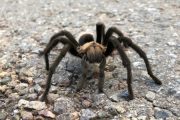Lying prone on his belly in the cavernous upstairs church hall, the teenage high school student squirmed about until he was comfortable with his position. Slowly he raised the 303 rifle and pointed it at the target, set about 100 feet away. He felt relaxed, comfortable, but eager to do well.
Taking careful aim he gradually put pressure on the trigger and was just about to fire when dark shadow passed in front of the bull’s eye. Quickly releasing his grip and lowering the rifle he looked up to see the school principal casually standing in front of the target, about to replace it with a new one. The principal, who was also the school’s rifle club coach, had just come within a second of receiving a 22 calibre bullet through one or both knees. He was never made aware of his close call. At that very moment, the teenager was spared the notoriety of becoming the school’s most infamous student in its history.
After setting the safety catch on his rifle, the distraught cadet placed it on the floor in front of him. With sweaty palms and a sigh of relief he lay his head on the butt of the rifle and shut his eyes. After a merciful pause the principal, with the wave of his hand, motioned that he could take his final shot of the practice session.
I know the precise details of that afternoon because I was that teenage boy. Before entering high school I had never shot a gun, although I lived on a farm, nor did I have any interest in the military. By the time I graduated from high school, I had become a highly-skilled, deadly accurate marksman, an accomplishment that led me unwittingly, to start my career on a military base.
As a fitting 16th birthday gift my family presented me with a brand new 22-calibre rifle. They knew that as a farm boy I had ample opportunities to take up hunting as a hobby. But intuitively, I had a very strong aversion to shooting helpless animals or birds. I used my new weapon solely for target practice. However, if WW 2 had started in 1949 instead of 1939, I might have been recruited to fight in Europe as a sniper, shooting soldiers. No doubt I would have died young. Even top marksmen seldom lasted long in war.
The school, Williamstown High, was tucked into the northeast corner of a tiny village by the same name, about 12 miles north of Cornwall, Ontario. Built in 1900, it served the surrounding rural community in that part of southern Glengarry County for 54 years. The building was a small, plain brick structure situated at the rear of a one-acre lot. A prominent cement sidewalk ran through the middle of a wide lawn, scattered here and there with shrubs, small trees and ornamental bushes. This walkway also served to separate the sexes. This demarcation line was strictly enforced, mostly by female teachers who randomly patrolled the area during students’ recess breaks to prevent boy-girl liaisons. The building’s unfinished attic was periodically used for target practice. Until the day the school was demolished in the 1960s, the roof rafters were punctured with bullet holes left there by unruly rifle club members who took extra shots when the coach was absent. But our stern principal, not known for his sense of humour, never discovered the unruly culprits.





